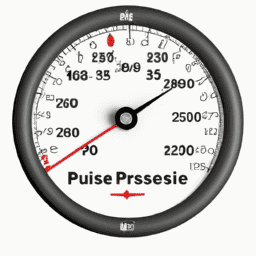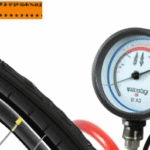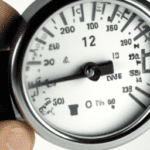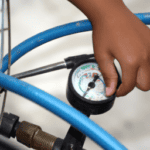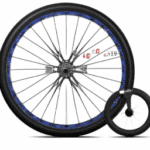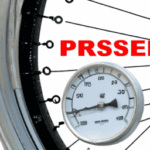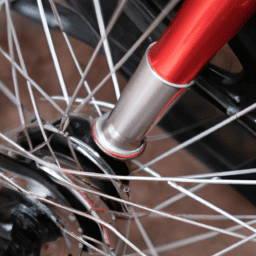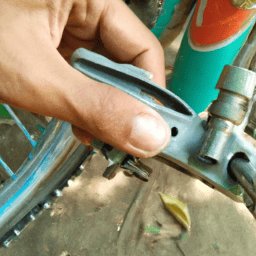Were you aware that the right tire pressure can significantly impact your biking performance? Indeed, research has demonstrated that keeping the tire pressure at the correct level can lower rolling resistance, enhance control, and avoid punctures.
So, how many PSI (pounds per square inch) should you be inflating your bicycle tires to? The answer is not as simple as you may think. The ideal tire pressure for your bike depends on several factors, including your weight, the type of bike you have, and the terrain you will be riding on.
In this article, we will guide you through the process of determining the right tire pressure for your bike and provide tips on how to maintain it. With the proper tire pressure, you can ride with greater ease and comfort, and enjoy your cycling adventure to the fullest.
Key Takeaways
- Proper tire pressure is crucial for cycling performance and safety.
- Ideal tire pressure depends on weight, bike type, and terrain, and can vary by up to 20%.
- Underinflated tires require more effort to ride and increase the risk of punctures, while overinflated tires decrease traction and may lead to blowouts.
- Regularly monitoring and adjusting tire pressure using a gauge is important for maintaining optimal performance and preventing issues.
Understand the Importance of Tire Pressure
It’s crucial to understand the importance of tire pressure when it comes to your bicycle’s performance and safety. Having underinflated or overinflated tires can significantly affect your bike’s performance.
Underinflated tires will cause the bike to require more effort to ride, decrease your speed, and make handling more difficult. On the other hand, overinflated tires can cause a harsh ride, decrease traction, and may even lead to a blowout. Therefore, maintaining optimal tire pressure is essential to ensure your bike performs safely and efficiently.
In addition to performance, maintaining optimal tire pressure also has a significant impact on safety. Underinflated tires are more prone to puncture, as the tire’s sidewalls are stretched, making them more vulnerable to impact. Overinflated tires, on the other hand, are more susceptible to damage from road debris, such as potholes and rocks, as they have less shock-absorbing ability.
Therefore, maintaining optimal tire pressure not only enhances your bike’s performance but also ensures your safety while riding. Now, let’s move on to determining the ideal tire pressure for your bike.
Determine the Ideal Tire Pressure for Your Bike
To ensure the best performance, you should find the recommended tire pressure for your bike model and weight, which can vary by up to 20% according to the terrain you’ll be riding on. Factors affecting tire pressure include the type of tire, the weight of the rider, and the terrain.
For example, if you’re riding on a rough or rocky terrain, you’ll want to increase your tire pressure to prevent punctures and improve your overall riding experience. Having incorrect tire pressure can lead to serious consequences, such as reduced traction, increased rolling resistance, and higher risk of punctures or blowouts.
If you ride with underinflated tires, you’ll also risk damaging the rims or causing premature tire wear. On the other hand, overinflated tires can cause a harsh ride and reduce the contact patch, making it more difficult to control your bike. Therefore, it’s important to find the ideal tire pressure for your bike and adjust it accordingly.
Use a tire pressure gauge to measure the pressure, and then adjust it as needed to ensure optimal performance.
Use a Tire Pressure Gauge
To ensure your bike tires are properly inflated, you’ll need to use a tire pressure gauge with proper technique.
Start by removing the valve cap and pressing the gauge onto the valve stem firmly.
Check the recommended PSI of your bike’s tire and adjust accordingly for the best performance and safety.
Keep in mind that different types of bikes require different PSI ranges, so always consult your owner’s manual or a professional for guidance.
Proper Technique for Checking Tire Pressure
Checkin’ the tire pressure like a pro can increase the lifespan of your bicycle tires. To ensure you’re checking your tire pressure correctly, there are a few techniques to keep in mind.
Firstly, avoid common mistakes like using your thumb to test the pressure, which can be inaccurate. Instead, use a tire pressure gauge to get the most precise measurement.
When checking the pressure, make sure your tires are cool because heat causes the tire pressure to increase, giving you an inaccurate reading. Once you have the gauge, unscrew the valve cap and press the gauge onto the valve stem. You should hear a hiss as air escapes, and you’ll get a reading on the gauge.
If the reading is below the recommended psi range, use a pump to inflate the tire. If it exceeds the range, release some air until it falls within the recommended psi. With these tips for beginners, you’ll be able to check your tire pressure like a pro in no time.
Now that you know the proper technique for checking tire pressure, it’s important to understand the recommended psi ranges for different types of bikes. This will vary depending on the type of bike you have, as well as your weight and riding style.
Recommended PSI Ranges for Different Types of Bikes
Understanding the appropriate air pressure range for your bike is crucial for improving performance and preventing potential damage. Different types of bikes require different PSI ranges due to variations in tire width, weight, and intended use.
Here are some recommended PSI ranges for different types of bikes:
- Road bikes: 80-130 PSI
- Mountain bikes: 30-50 PSI
- Hybrid bikes: 50-70 PSI
- Cruiser bikes: 30-40 PSI
- BMX bikes: 35-65 PSI
It’s important to note that these are general recommended ranges, and specific tire models may have different optimal PSI levels. Additionally, the terrain you’ll be riding on can impact tire pressure.
For example, if you’re riding on rocky terrain, you may want to slightly decrease your tire pressure to improve traction. On the other hand, if you’re riding on smooth pavement, you may want to slightly increase your tire pressure for reduced rolling resistance.
Adjusting tire pressure as needed can greatly improve your riding experience and prevent potential damage to your bike.
In the next section, we’ll discuss how to properly adjust your tire pressure to ensure optimal performance.
Adjust Tire Pressure as Needed
Make sure you regularly adjust your tire pressure as needed to ensure a smooth and safe ride. For example, if you notice that your bike is bouncing too much on bumpy roads, it may be a sign that you need to increase the tire pressure. On the other hand, if your tires are too hard, you may experience less traction, making it harder to control the bike. This is why it’s important to find the right balance in tire pressure.
To help you find the right tire pressure for your bike, refer to the table below. It lists the recommended pressure ranges for different types of bikes. Keep in mind that these are just general guidelines and you may need to adjust the pressure based on your weight, the type of terrain you’ll be riding on, and other factors. Also, make sure to monitor tire pressure regularly to ensure that it stays within the recommended range.
| Bike Type | Rider Weight | Front Tire Pressure Range (psi) | Rear Tire Pressure Range (psi) |
|---|---|---|---|
| Road | Up to 120 lbs | 80-100 | 80-100 |
| Road | 120-140 lbs | 90-100 | 90-100 |
| Road | 140-160 lbs | 100-110 | 100-110 |
| Mountain | Up to 120 lbs | 30-50 | 35-55 |
Make sure to monitor tire pressure regularly to avoid the effects of underinflated tires, such as increased rolling resistance and risk of pinch flats, or overinflation risks, such as reduced traction and increased risk of blowouts. By doing so, you’ll not only prolong the life of your tires but also have a safer and more comfortable ride.
Monitor Tire Pressure Regularly
Now that you know how to adjust your tire pressure, it’s crucial to monitor it regularly. This ensures that your tires maintain the optimal pressure level, which is crucial for a safe and comfortable ride. Without proper inflation, your bike’s performance can suffer, and you may even risk damaging your tires.
To help you keep track of your tire pressure, here are four benefits of using a digital gauge and the importance of maintaining consistent tire pressure:
-
A digital gauge is more accurate than traditional gauges, providing precise readings that help you inflate your tires to the recommended pressure level.
-
Consistent tire pressure ensures that your tires wear evenly, reducing the risk of blowouts or flats.
-
Proper inflation maximizes your bike’s efficiency, making it easier to pedal and maintain speed.
-
Monitoring tire pressure regularly helps you catch any issues early on, preventing more significant problems down the road.
Overall, keeping a close eye on your tire pressure and using a digital gauge can help you enjoy a safer, more comfortable ride. So make sure to check your tires before every ride and maintain consistent pressure levels for optimal performance.
Frequently Asked Questions
Can I use a car tire pressure gauge for my bike tires?
"You can use a bike tire pressure gauge or alternatives such as a digital pressure gauge or a floor pump with a built-in gauge for more accurate readings. Comparing accuracy with a car tire pressure gauge may vary due to different pressure ranges." ‘It’s important to check your bike tire pressure regularly and ensure that it falls within the recommended range specified on the tire sidewall or in the owner’s manual.’
Is there a difference in tire pressure for different types of bike tires (mountain bike vs road bike)?
Like a well-oiled machine, your bike’s performance depends on proper tire pressure. Lower pressure on mountain bikes provides better grip and comfort. Optimal pressure for different road terrains maximizes speed and efficiency.
How often should I check my bike tire pressure?
To ensure optimal performance, safety, and longevity of your bike tires, check the pressure at least once a week. Proper tire pressure improves handling, reduces rolling resistance, and prevents flats. Common mistakes when checking pressure include using a gauge that is not calibrated or using the valve stem to release air.
What happens if I overinflate my bike tires?
Avoid overinflating your bike tires as it can make them more prone to punctures, reduce grip, and affect ride comfort. Always follow the recommended psi for optimal performance. Check tire pressure regularly using a gauge or your finger to ensure proper inflation.
Is it safe to ride with low tire pressure?
Riding with low tire pressure can be risky, affecting handling, speed, and causing flats. Proper inflation is important for safety and performance. Consult your bike manual or a professional for recommended psi.
Conclusion
Congratulations! You now know how important it is to maintain the proper tire pressure for your bike. By determining the ideal tire pressure and regularly monitoring it, you can ensure a smooth, safe, and comfortable ride.
Remember, using a tire pressure gauge is the best way to accurately measure your tire pressure. Don’t rely on visual cues or guesswork, as this can lead to underinflation or overinflation. Adjust your tire pressure as needed based on the manufacturer’s recommendations and the type of terrain you’ll be riding on.
So, the next time you hit the road or trail, make sure your tires are properly inflated. Your bike will thank you for it.
Keep in mind that maintaining the correct tire pressure is not only important for your bike’s performance, but also for your own safety. After all, you wouldn’t want to be caught in a sticky situation with a flat tire!
